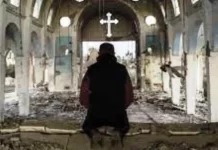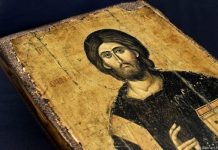Muslim Persecution of Christians, January 2015
Raymond Ibrahim
April 19, 2015
http://www.gatestoneinstitute.org/5585/muslim-persecution-of-christians
A pastor eventually helped the 12 year old to a “medical clinic, where she was treated for two weeks, while her father began organizing area Muslims to kill her.””The intention was to torch all the churches with us inside them” and thus “burn is alive.” — A nun in Niger.
Before we put on a show of unity with the Muslims, let’s have them begin by respecting our civilization and our culture.” — Giuseppe Berlin, Councillor, Cinisello Balsamo, Italy.
The New Year began with Muslim gunmen killing a dozen people at the offices of the satirical magazine, Charlie Hebdo, in Paris on January 7, 2015. The attack was motivated by the publication of unflattering caricatures of Islam’s prophet, Muhammad.
Less known is that all throughout the Islamic world, the magazine’s caricatures of Muhammad were blamed on Christianity by Muslims, who seemed not to realize that the magazine habitually pokes fun at Christ, Moses, and all other religious figures. In the Palestinian territories, for example, protesters held up a sign with images of the Muslim killers behind the Charlie Hebdo massacre; the caption below said “Expect more from the champions of Islam, O you slaves of the Cross” (bold in original Arabic).
Accordingly, Muslims around the Islamic world attacked Christian minorities by way of “collective punishment.”
In Niger, in response to the Muhammad cartoons, Muslim mobs, reportedly spurred on by the Islamic terrorist group, Boko Haram, torched approximately 45 Christian churches, a Christian school and orphanage, pastors’ homes and two nuns’ convents. At least 10 people were killed in the clashes; pastors in the capital, Niamey, said that anyone associated with churches—anyone exposed as Christian—was targeted.
According to a nun who escaped the violence, “The intention was to torch all the churches with us inside them” and thus “burn us alive. Boko Haram students believe they must kill Christians in order to take their place in paradise but we won’t surrender to fear because love must prevail over hatred.”
In Pakistan, some 300 Muslim students armed with iron bars and sticks and shouting anti-Christian slogans, attacked a Christian boys’ school in “retaliation” for the Muhammad cartoons. Four Christian students were injured. According to eyewitnesses, the three officers hired to guard the school stood by and watched.
“It is very sad that Islamic radicals attack Pakistani Christians because of Charlie Hebdo,” said Nasir Saeed, director of the NGO Center for Legal Aid Assistance & Settlement, of the attack. “Christians condemn the blasphemous cartoons. It is a shame that even after 67 years since the birth of Pakistan, Christians have not yet been considered Pakistani citizens, but are seen as “Western allies”…. Whenever incidents occur in western countries, the faithful Pakistanis are attacked. Christians, who are already living under constant fear for their lives, become even more vulnerable.”
From an Islamic perspective, in fact, people are not classified according to nationality, but religion. It is irrelevant that those who insult the prophet of Islam are French, or European, or American. To Muslims around the world, all those terms are synonymous with “Christian.” Thus, years before the world heard of “ISIS,” Christian minorities in Iraq were being targeted and killed “over their religious ties with the West.”
The rest of January’s roundup of Muslim persecution of Christians around the world includes, but is not limited to, the following accounts, listed by theme and country in alphabetical order, not necessarily according to severity.
Death and Destruction at Christian Churches
Egypt: The courtyard of St. George the Martyr, a partially constructed Catholic church in Hijazh village, was set on fire by unknown persons on Christmas day (January 7 for Egyptian Christians). Christian worshipers, who had been planning to pray in the church’s courtyard — due to Muslim protests, the church had been left unfinished for 23 years — had furnished it with chairs and tents. They “were surprised” to find “flames” engulf much of the courtyard. In 2010, a wooden church build beside the unfinished church had also been burned down, although at that time faulty electricity was blamed. Pictures can be seen here.
Separately, on January 25— the anniversary of Egypt’s “Arab Spring”—gunshots were fired at the church of St. Raphael the Archangel in Maadi. Several Coptic Christians were killed, including a child, Mina Rifa’at. In other areas, such as Beni Suef, security forces closed the streets around the churches to prevent attacks by gangs affiliated with the Muslim Brotherhood. According to the local bishop, Antonios Aziz Mina, “clashes occurred between the police and groups linked to the Muslim Brotherhood, that aim to credit the image of a still destabilized Egypt.”
Italy: Churches, crosses, and religious statues were attacked in the European, Catholic-majority nation: On New Year’s Day, a 67-year-old Moroccan man, seen mumbling verses from the Koran, used an iron rod to hurl to the ground and severely damage five statues and other religious objects in the parish church of Santa Maria Assunta in Cles, Trentino. He threw to the ground the statue of the Madonna and Child, the Immaculate, those of Our Lady of the Rosary and Our Lady of Sorrows and the statue of St. Joseph with the Child. He also shattered the marble altar and the baptistery two altars and a large painting of the Assumption. All damaged items are cataloged at the Superintendence for Cultural Heritage of the Autonomous Province of Trento. He was arrested by police on the charge of aggravated damage.
Then, on January 9, in the chapel of St. Barnabas in Perugia, as a man holding the photograph of a loved one was kneeling in prayer before a St. Mary statue, five “foreigners,” described as being of North African descent, attacked him. “The first thing they did was rip the photo from his hands. Next they unleashed their hatred against the image of the Virgin Mary. They broke the statue to pieces and then urinated on it,” said the Italian language report.
Finally, on January 17, a crucifix was destroyed in Cinisello Balsamo, a municipality in the Province of Milan, near a popular mosque. The municipality’s Councillor, Giuseppe Berlin, did not mince words concerning the identity of the culprit(s): “It’s time to put an end to the do-gooders’ policies of welcoming and integrating by a certain political party. Before we put on a show of unity with Muslims, let’s have them begin by respecting our civilization and our culture. We shouldn’t minimize the importance of certain signals; we must wake up now or our children will suffer the consequences of this dangerous and uncontrolled Islamic invasion.”
Kenya: An unknown gunman shot a Christian dead at the gate leading to a church on Sunday, January 11 in Mombasa. As George Muriki, 25, arrived with two other church members at the gate leading to Maximum Revival Ministries Church, one of two men who had been following him shot him three times in the back, apparently after mistaking him for the church pastor. According to the pastor, “The two other church members, who happened to be ladies, were pushed aside and one of the attackers said, ‘This is the church pastor,’ and there and then the attackers fired three times right at the back of George, who died at the spot…. My life is in danger—I know I was the target, but God protected…. Someone has been following me for the last one month.” The pastor later named his stalker as “Mohammed.” “The school hall also is not safe,” he added. “We have to move to another location; otherwise we are going to lose many members who are now afraid to come to church.”
Nigeria: During a New Year church service, an Islamic suicide bomber blew himself up at the gates of a church in the city of Gombe. Eight people were wounded. In the words of a Red Cross official: “This morning [January 1] while people were in church for the New Year worship, a suicide attacker rode on a motorcycle trying to gain entrance to the premises of the church. When he was stopped at the gates by the church guards … he blew himself up and injured eight people.” Separately, after several Western mainstream media reported that Nigeria’s Muslims protected Christian churches during Christmas Day celebrations, the Christian Association of Nigeria (CAN) debunked such claims. “It has,” they said, “become imperative for us to clarify this falsehood and confusion in local and international media. Many of our members have been calling and asking questions whether a Church was protected from being attacked by Muslims in [the] Sabo area on Christmas day? And we said it is not true.” CAN added that, contrary to Western media reports, not one of 600 churches was protected by Muslims on Christmas.
Pakistan: On December 29, a Protestant Christian church was set on fire, leaving the Christian community in “dismay and terror.” According to Pastor Qamar Zaman, in charge of the pastoral care of the affected community, “it is an act of intimidation to spread terror and create enmity between Christians and Muslims.” Responding to this incident, lawyer and activist Sardar Mushtaq Gill said: “Christians in Pakistan suffer from a sense of distrust and fear. Extremists continue to sow terror in the minds of citizens and have no regard either towards the people or the holy places. They want to create disharmony among the faiths in Pakistan and create unrest in the country. Our answer can only be a response of faith and prayer.”
Syria: On January 9, a number of Christian churches in Aleppo, some around 200 years old, were bombed by Islamic rebels. Among them was the Armenian Catholic Cathedral, St. Rita — or, “Our Lady of Pity,” built in 1830 — which was left partially destroyed (pictures here). According to Rev. Fr. Krikor Milad, based in Aleppo, the bombing took place around 5:30 a.m., while everyone slept: “If the bombing had taken place just two hours later, the church would have been full of worshippers. God saved them.” Four months earlier, the Armenian Genocide Memorial and Church of Der Zor was destroyed by the Islamic State. Separately, on January 30, two pickup trucks, carrying twenty armed members of the Islamic State entered the Assyrian town of Tel Hormizd in Hassaka and forced the residents to remove the cross from the church tower. The leader threatened to bomb the church if the cross were not removed. Unable to defend themselves, the residents complied. The aftermath of the March 2014 Islamist takeover of the Armenian town of Kessab was detailed in a Telegraph report after government forces liberated the Christian town. The report tells of the many churches destroyed, crosses broken, and images of Christ and Virgin Mary defaced: “The perpetrators had shown both purpose and glee in their destruction of Christian sites in this ancient Armenian town. Statues were riddled with bullets and Islamist slogans were scrawled across the walls of homes and shops…. Nearby, the Holy Trinity Armenian Evangelical church was little more than a burned shell. Walls were blackened by smoke; wooden pews, tapestries, Bibles and kneeling cushions had all been incinerated in a fire that appeared to have raged until there was nothing left to burn.” “I was at home with my husband when they raided the house,” Zavinar Sargdegian, a 58-year-old resident, explained her ordeal. “They broke down the front door. They pushed us on to the street. We were on our knees and they put a gun to our heads. From the road I saw the Angelic Church burning. Fire was coming out of the doors and windows.”
Death to Apostates
Uganda: A Muslim father and imam, or prayer leader, beat his 15-year-old daughter to death for converting to Christianity and was reportedly trying to kill her hospitalized,12-year-old sister, also for abandoning Islam for Christ. According to a local source, around mid-December, “Their father got the information that his daughters have converted, and he organized a small group of fellow Muslims, about 17 people, to go and attack the Christians. He found the [church] campaign had finished but went back to his home and waited for the daughters. When they went back home, the father picked up the club and started beating them badly till one called Jamirah died.” The younger, Saidah, described her ordeal as follows: “My father took us to the house and then locked the house. He questioned us why we attended a Christian meeting and started beating us up with a club. My sister was hit on the forehead and fell down. I tried to hide myself in the bed, but he got me out and began beating me up as my sister lay down bleeding.” Saidah began shouting for help, but her father covered her mouth with such force that she nearly suffocated. She fell down, unconscious. A pastor eventually helped her to “a medical clinic, where she was treated for two weeks, while her father began organizing area Muslims to kill her.”
Murder and Dhimmitude
Egypt: On January 13, a Christian man was shot to death in broad daylight “for what family members believe was their refusal to drop charges against the suspect’s relatives in other religiously motivated killings in 2013.” The gunman, Hasan Baghdadi, was arrested the following day. He and his brother, Mohamed, ambushed 38-year-old Shaheed Nesemis Saroufeem—a cousin of a Christian who was killed along with three other Copts in July 2013. The Baghdadi brothers are related to at least one of those accused in the 2013 killing. Mohamed, said local Copts, is an Islamist who regularly incites violence against Christians in the area. Separately, another young Coptic Christian girl, Sabrine Mushir, was kidnapped in the village of Dalga.
Coptic activists complained that not a single person from among the authorities and security apparatus did a single thing to try to find the girl. As one family member said, “If this were the daughter of one of the local authorities, she would have been retrieved in seconds.” Dalga, where the young Christian girl was kidnapped, is the same Upper Egyptian village where, in September 2013, Muslim Brotherhood sympathizers forced the Christian inhabitants to pay Islamic jizya—the money, or tribute, that vanquished non-Muslims historically had to pay to their Islamic overlords “with willing submission and while feeling themselves subdued,” in the words of Koran 9:29. In some cases, those not able to pay were attacked, and their wives and children beaten or kidnapped.
Iraq: The Islamic State expelled 10 elderly Christians from Mosul after they refused to renounce their Christian faith and convert to Islam. On Wednesday, January 7 the group of elders—some with serious health problems—was welcomed in Kirkuk, after spending two days in the cold and traveling in “no man’s land.” “They had thrown us out from our villages and our homes to occupy them—said one Rachel—and then we were all clumped together in a residence in Mosul.
Kazakhstan: Nikolai Novikov, a devoted Baptist church member, was banned from leaving the country, and faced other charges, because he refused to pay fines equivalent to a monthly wage for attending a Christian worship meeting without state permission: “I didn’t pay because I don’t consider myself guilty,” said the Christian, who was also jailed for five days. Novikov, a 34-year-old married father of four living in the city of Oral (Uralsk), is among the most vocal voices against a government crackdown on Christians who express their faith openly or gather without state permission.
About this Series
While not all, or even most, Muslims are involved, persecution of Christians is expanding. “Muslim Persecution of Christians” was developed to collate some — by no means all — of the instances of persecution that surface each month.
It documents what the mainstream media often fails to report.
It posits that such persecution is not random but systematic, and takes place in all languages, ethnicities and locations.
Raymond Ibrahim is author of Crucified Again: Exposing Islam’s New War in Christians (published by Regnery in cooperation with Gatestone Institute, April 2013).
Previous reports
-
December, 2014
-
November, 2014
-
October, 2014
-
September, 2014
-
August, 2014
-
July, 2014
-
June, 2014
-
May, 2014
-
April, 2014
-
March, 2014
-
February, 2014
-
January, 2014
-
December, 2013
-
November, 2013
-
October, 2013
-
September, 2013
-
August, 2013
-
June, 2013
-
May, 2013
-
April, 2013
-
March, 2013
-
February, 2013
-
January, 2013
-
December, 2012
-
November, 2012
-
October, 2012
-
September, 2012
-
August, 2012
-
July, 2012
-
June, 2012
-
May, 2012
-
April, 2012
-
March, 2012
-
February, 2012
-
January, 2012
-
December, 2011
-
November, 2011
-
October, 2011
-
September, 2011
-
August, 2011




















